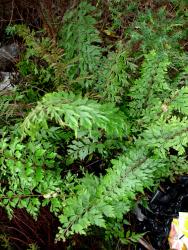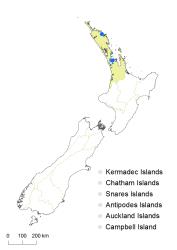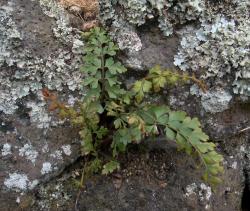- ≡ Trichomanes aethiopicum Burm.f., Fl. Ind. (N.L. Burman) 28 [32] (1768)
Terrestrial or rupestral ferns. Rhizomes short-creeping, bearing scales. Rhizome scales acicular with filiform apices, 3–6 mm long, 0.2–0.5 mm wide, dark brown, clathrate. Fronds 110–630 mm long. Stipes 35–280 mm long, blackish-brown, bearing abundant narrowly ovate scales with filiform apices. Rachises dark brown for most of their length, becoming green distally, densely scaly. Laminae 1–2-pinnate-pinnatifid, ovate, narrowed to a pinnate apex, 75–350 mm long, 45–160 mm wide, dark green adaxially, paler green abaxially, coriaceous, bearing dense scales, lacking hairs. Primary pinnae in 6–17 pairs below pinnate apex, ovate or narrowly ovate; the longest below the middle, 23–110 mm long, 14–60 mm wide, apices acuminate, bases stalked; costae of primary pinnae winged at least in distal half or sometimes throughout. Secondary pinnae gradually decreasing in length along each primary pinna to the distal end; the longest proximal secondary pinnae elliptic or ovate, 10–43 mm long, 4–12 mm wide, apices acute or acuminate, obtuse on smallest fronds, deeply incised into long narrow ultimate segments, margins entire, bases cuneate and sessile or shortly stalked; the distal secondary pinnae narrowly elliptic, apices acuminate or attenuate and incised, bases adnate. Sori away from margins; indusia 4–10 mm long, straight; free margins of indusia entire. Mean spore size 42.5 μm long, 27.4 μm wide; perispores pale, with broad ridges and smooth lacunae.
Asplenium aethiopicum is recognised by its dark brown stipe and rachis, darker green adaxial lamina surface, and 1–2-pinnate-pinnatifid laminae with long, narrow ultimate segments.
North Island: Northland, Auckland.
Altitudinal range: 10–60 m.
A widespread and polymorphic species of tropical and southern Africa, southern India, Sri Lanka and Australia (Western Australia, Queensland, New South Wales, Victoria), now naturalised in Auckland, and occurring as self-sown plants around cultivated plants in Kerikeri.
Established in cracks in mortar and masonry of walls, or drainage gutters, sometimes in the vicinity of cultivated plants.
Heenan et al. 2004. Voucher: AK 284004, 2003.
Braithwaite (1986) described an extensive polyploid series with three sexual cytotypes (n = 72, 144, and 216) and two apomictic cytotypes (2n = 288 and 360) in South African populations of this species complex. The cytotypes are recognised as separate subspecies, and each has spores of different sizes. In Australia there are two different entities of this complex occurring in Western Australia and the eastern states, respectively (Brownsey 1998). Tindale & Roy (2002) reported chromosome counts of n = c. 72 in New South Wales and n = c. 180 in Western Australia. The New Zealand plants appear most similar to those in Western Australia, but further work is required to determine the ploidy of New Zealand plants and their subspecific relationships.






